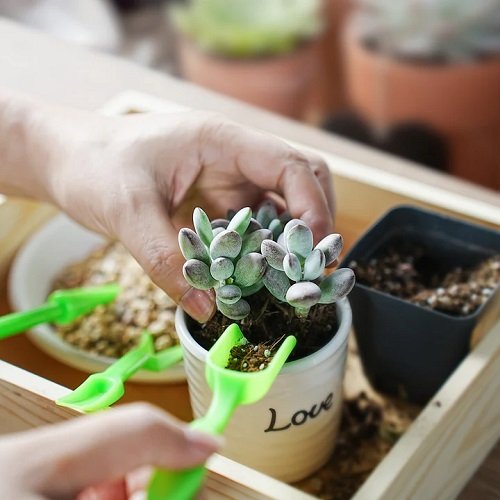Want to know about the Secret Hacks for Colorful Succulents? Read ahead to know how to keep them vivid and bright all year round!

Succulents, when they remain green, do not look as appealing as they do when they are in all their colorful glory with vibrant hues! Follow these Secret Hacks for Colorful Succulents to make sure you have the best display of them!
Check out pretty succulents that change color here
Secret Hacks for Colorful Succulents
1. Pick the Right Variety

If you are fond of colored succulents, you should start with the ones that come in vivid shades. Varieties like Echeveria ‘Rainbow,’ Aloe ‘Firecracker,’ Kalanchoe ‘Flapjack,’ Sedum ‘Blue Elf,’ and Graptoveria ‘Debbie,’ are the best ones to start with.
Don’t worry if you’re not setting up a garden for the first time, we’ll help you make your existing succulents colorful, too.
23 Most Stunning Orange Succulents
2. Keep them Slightly Stressed

Stressing up your succulent will help you trigger a change in color. How so? Several environmental fluctuations cause these changes, some of which are:
- Change in Temperature and Season: The flavonoids in succulents protect from falling temperatures, which is why some succulents change color when the temperature reduces.
- Alteration in Sun Exposure: When succulents face stress, they create anthocyanin, a color superhero. When it receives more sunlight, anthocyanin production increases to fight potential harm from UV rays. So, changes in sunlight will result in your plant taking a vivid hue.
- Change in Water Levels: You can also experiment with reduced watering and watch anthocyanin levels rise, painting your succulent in a riot of colors!
Not all succulents change colors when they are stressed. Some of the popular ones that do are Sedums, Aloes, Kalanchoes, Crassulas, Euphorbias, Aeoniums, Sempervivums, and Echeverias
Note: Find the sweet spot between underwatering and overwatering. While reduced watering can enhance color intensity, it’s crucial not to let your succulent become too thirsty.
3. Keep them Slightly Root Bound

Keeping succulents in a root-bound stage puts them under stress, and they become colorful in such situations. Stressed succulents are like chameleons—they change colors! So, if you want those vivid hues, let your succulent feel a bit cramped.
You can do this by giving it a smaller pot. Now, giving your succulent a huge, comfy pot might sound nice, but it’s like a vacation for them. In these spacious containers, instead of showing off their colors, they focus on growing more roots. But in a smaller one, they’re stressed.
9 Succulents that Make You Lucky | Good Luck Succulents
Here’s another catch: big pots usually hold more water. So a smaller one would stress your succulent just right and not burden it. Too much water can lead to root rot, a big no-no for succulents.
To keep your succulents stressfully happy and colorful, let them live a little cramped!
4. Know Where to Keep Them
Most succulents are like Goldilocks—they want a mix of sunlight and shade. Too much sun (8-10 hours of full sun) is like a sunburn session for them. On the flip side, not enough sun makes them all lanky and stretched out, like they’re reaching for the light.
If you want to make your succulents more colorful, acclimate them to more sunlight gradually, as sudden changes can burn the leaves. Lack of sunlight causes a faded hue, whereas heat and cold (not freezing) bring out darker shades.
Some succulent varieties become more colorful in winter, and some in spring when they receive sunny, warm days and cool nights.
5. Take Your Succulents Outdoors

Take your indoor succulents outdoors in warmer months. Allow them to bathe in rainwater as it contains oxygen and trace minerals that plants don’t get from tap water. Succulents will also benefit from air circulation that they lack indoors.
Note: Now, a word of caution for this succulent color hack. Don’t throw your indoor succulents directly into the blazing sun. They’re not used to it, and sudden changes in light can be a shock, leading to burnt leaves.
Introducing Succulents Outdoors Properly
- Shade Introduction: To initiate the transition, you need to begin by placing indoor succulents outdoors in a shaded area.
- Gradual Exposure Increase: Move them to spots with increasing sunlight gradually over a week, starting with filtered sunlight.
- Morning Sun First: Go with the morning sunlight before exposing them to direct sunlight, slowly extending the exposure time.
- Monitor and Adjust: Keep a close eye on your succulents during the process, adjusting their exposure based on their response to prevent stress or sunburn.
Learn Succulent Ball Ideas here
6. Temperature Changes Do Wonders

Temperature plays a vital role in enhancing the color of succulents, as some varieties change their shade in cold weather. Similarly, warm temperatures also impact the hue of these fleshy plants.
Succulents That Change Color in Cold Temperatures
- Euphorbia ‘Sticks on Fire’
- Senecio mandraliscae
- Aloe
- Sempervivum ‘Pluto’
- Crassula ‘Campfire’
Succulents That Change Color in Warm Temperatures
- Agave potatorum (Verschaffelt Agave)
- Portulacaria afra (Elephant Bush)
- Lampranthus glaucus (Ice Plant)
- Opuntia (Prickly Pear Cactus)
- Variegated Sedum (Stonecrop)
You can experiment with the temperature to determine how your succulent changes color.
14 Best Spiny Succulents
7. Fertilizer Your Succulents Right

Feed your succulents once in 5-8 weeks in the growing season from spring to early fall, with succulent or any balanced fertilizer having equal NPK diluted to one-quarter of its recommended strength.
Note: Avoid fertilization during winter.
Bonus – Let Them Be Dormant
During winter months, many succulents enter a dormancy phase, slowing down their growth. Rest is natural and contributes to their health. While they might not be as actively colorful, this is a crucial time for them to recharge to become colorful succulent plants for the growing season.
Remember: Let your succulents take a beauty nap during winter, and they’ll reward you with a vibrant display when the growing season returns.



